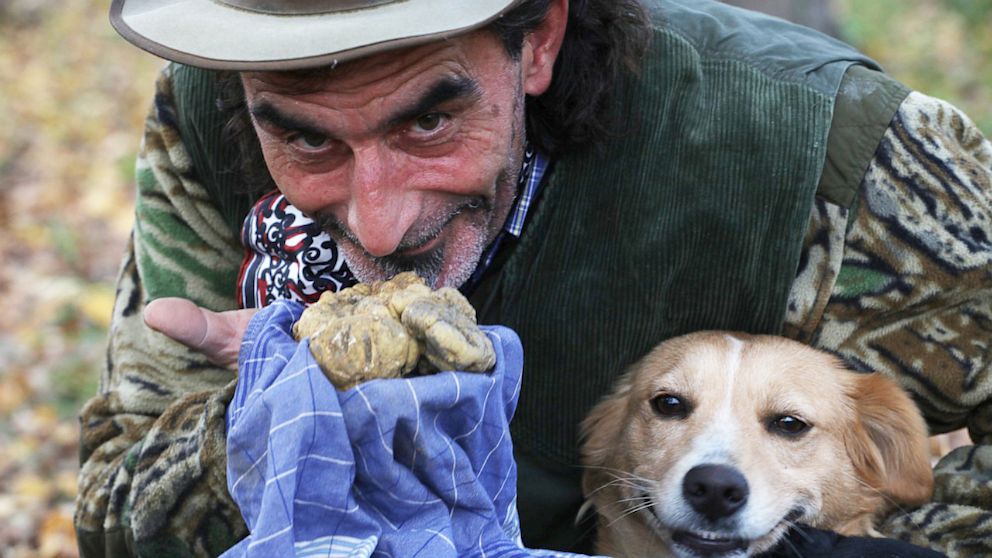The Joy Of Harvest Season in Northern Italy
The hillsides are ripe with wine grapes, olives, mushrooms and more.

Oct. 4, 2013— -- intro: Harvest season is when Italy's three key farming and wine regions come into their peak. It's a joyful time, because it's when the local people bring in the crops they've carefully hand-tended throughout the year—and locals and visitors alike dedicate themselves wholeheartedly to wine-soaked gastronomic discovery.
quicklist: 1title: Hillside Overlook, Acqui Termetext: In Piedmont, the picturesque northwest region at the foot of the Alps, harvest draws international visitors to the tiniest villages and most out-of-the way hillside regions. More and more people are rediscovering what the Piemontese never forgot: i.e. the "slow food" philosophies of being in touch with the land, in harmony with the seasons, and cultivating/harvesting food by hand. media: 20458581
quicklist: 2title: Vineyard worker, Monferrato Districttext: For more than 2,000 years, wine production has been the main industry in Piedmont, followed by other types of agriculture. The picking season starts in late August with the "aromatic varieties" of Brachetto and Moscato, and winds up in November with Nebbiolo.media: 20458638
quicklist: 3title: Truffle Hunter, Piedmonttext: Probably the only other harvest to garner as much international attention as the wine crush is la raccolta de funghi (wild mushroom picking season). This takes place in local forests all around Piedmont from September through November. Pungent white truffles are the king of funghi, but other local mushroom varieties like porcini and ovuli are popular as well. Local restaurants have special seasonal menus featuring fresh mushrooms in every course.media: 20459037
quicklist: 4title: Porta Palazzo Market, Turintext: To sample the local harvest without going into the forest or the fields, pay a visit to the farmers market. Pictured is the largest market in all Europe – but all towns and even the tiniest villages in the Piedmont region have weekly or twice-weekly markets of their own. Jams from vineyard grapes and other local fruits, roast chestnuts, late-summer peppers in olive oil, and cardoons with bagna cauda (hot garlic sauce) are just a few of the simple but delicious local delicacies to try.media: 20458701
quicklist: 5title: Moscato Vineyard, Monferatto Districttext: In most of the hillside vineyards, the steep and treacherous terrain makes it impossible to run modern picking machines, so grapes are still harvested by hand as they have been for hundreds of years. Without heavy machinery operating from dawn till dusk, the vineyards have a timeless appeal – although make no mistake, the vinification facilities are oftentimes state-of-the-art.media: 20458714
quicklist: 6title: Brachetto Time at Zelig Cabarettext: Although most Americans are familiar with the classic Italian red varietals such as Barolo, Brachetto is the red wine to discover during a Piedmont visit. Locals drink it as an aperitif, for dessert, and at celebratory occasions--where it's said to bring families together because it can be drunk from youth to old age. While currently produced in smaller quantities than most other Italian wines, the increasing popularity of Brachetto in major US cities indicates that soon, this effervescent red-fruit sipper might overtake mighty Moscato as the sparkling wine for tastemakers.media: 20458748
quicklist: 7title: Sunset at Baravalle, Calamandranatext: Some wineries will let visitors spend a few days in the vineyard working side-by-side to harvest the grapes, and can even arrange for them to go to the woods to forage for chestnuts and mushrooms. Baravalle is one picturesque vineyard/farm estate in the Piedmont region that allows visitors to take part in its agricultural program and overnight in comfortable lodgings on the grounds.media: 20458768
quicklist: 8title: Calamari, La Curiatext: Because the seaside region of Liguria is Piedmont's neighbor to the south, seafood is also an important part of the Northern Italian gastronomy. Local restaurants feature a lot of anchovies, calamari, bluefish and cod (the main catches from the Ligurian Sea). Bluefish – once eaten mainly by farmers and other working-class types-- enjoyed an unexpected surge in popularity recently, when dietitians discovered that the inexpensive fish is extremely high in Omega-3.media: 20458791
quicklist: 9title: Marenco Winery, Strevitext: More than just ornamental, rose bushes have historically been used as an indicator of pests or mildew in the vineyards. Roses are even more sensitive than grapevines are, so a drooping rose bush would alert vineyard managers to use traditional anti pest-control methods like copper sulfate on the microscopic intruders before they could compromise the harvest.media: 20458807
quicklist: 10title: Rice fields, Vercellitext: The province of Vercelli is Italy's key rice-growing region because of its humid climate and proximity to the Po River. Though not the most picturesque crop compared with the gloriously tended hillside vineyards, the Arborio rice grown here provides most of Italy with their staple dish of risotto, and is also exported to the US, Japan and many European countries.media: 20458848




